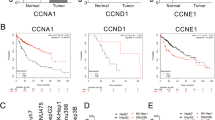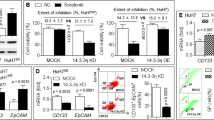Abstract
To investigate the synergistic effect of EMS1-PSilencer4.1-shRNA (EMS1-shRNA) and sorafenib on biological behaviors of HCC cell line SMMC-7721. EMS1-shRNA was constructed and transfected into SMMC-7721 cells. Decreased levels of EMS1/cortactin were tested in RT-QPCR and Western blot assay. Proliferation, migration, invasion, and endocytosis of SMMC-7721 were tested through CCK8 assay, scratch test, transwell invasion assay and transferrin endocytosis assay, respectively. Raf-1 was detected by Western blot assay. HCC xenograft model was prepared to observe tumor growth. Animals were euthanized and their subcutaneous lesions were weighed. Then the tissues were fixed and paraffin sections were prepared. Cortactin and PCNA (a proliferation marker) were then detected by immunohistochemistry. As compared with untreated group, the levels of EMS1 gene and cortactin protein in EMS1-shRNA-transfected group were significantly reduced; Among EMS1-shRNA-transfected group, sorafenib-treated group and combined group, the levels of proliferation at 48 h were reduced to 83.69, 57.18, 41.94 %; the levels of migration were reduced to 49.69, 60.83, and 21. 67 %; the levels of invasion were reduced to 42.97, 53.65, 18.18 %; the levels of endocytosis were reduced to 37.15, 97.95 % (p > 0.05), 20.68 % (p < 0.05, respectively). Western blot assay showed levels of Raf-1 were reduced to 68.56, 59.09, 21.90 %. The tumor volume and weight of nude mice HCC xenograft tumors were reduced significantly either (p < 0.05, respectively). Immunohistochemistry showed levels of cortactin and PCNA were reduced to 35.69, 93.84, 23.68 and 87.69, 43.84, 33.68 % in each group, respectively. The biological behaviors of SMMC-7721 were inhibited in the presence of EMS1-shRNA and sorafenib both alone and in combination. The combination of the agents improved the curative effect over either single agent, showing synergetic effect.











Similar content being viewed by others
References
Avila MA, Berasain C, Sangro B, Prieto J (2006) New therapies for hepatocellular carcinoma. Oncogene 25(27):3866–3884
Bowden ET, Barth M, Thomas D, Glazer RI, Mueller SC (1999) An invasion-related complex of cortactin, paxillin and PKCmu associates with invadopodia at sites of extracellular matrix degradation. Oncogene 18(31):4440–4449
Brown LA, Irving J, Parker R, Kim H, Press JZ, Longacre TA, Chia S, Magliocco A, Makretsov N, Gilks B, Pollack J, Huntsman D (2006) Amplification of EMSY, a novel oncogene on 11q13, in high grade ovarian surface epithelial carcinomas. Gynecol Oncol 100(2):264–270
Cheng A-L, Kang Y-K, Chen Z, Tsao C-J, Qin S, Kim JS, Luo R, Feng J, Ye S, Yang T-S, Xu J, Sun Y, Liang H, Liu J, Wang J, Tak WY, Pan H, Burock K, Zou J, Voliotis D, Guan Z (2009) Efficacy and safety of sorafenib in patients in the Asia-Pacific region with advanced hepatocellular carcinoma: a phase III randomised, double-blind, placebo-controlled trial. Lancet Oncol 10(1):25–34
Daly RJ (2004) Cortactin signalling and dynamic actin networks. Biochem J 382:13–25
Hanahan D, Weinberg RA (2000) The hallmarks of cancer. Cell 100(1):57–70
Higgs HN, Pollard TD (2001) Regulation of actin filament network formation through ARP2/3 complex: activation by a diverse array of proteins. Annu Rev Biochem 70:649–676
Huang C, Ni Y, Wang T, Gao Y, Haudenschild CC, Zhan X (1997) Down-regulation of the filamentous actin cross-linking activity of cortactin by Src-mediated tyrosine phosphorylation. J Biol Chem 272(21):13911–13915
Hwang YH, Choi JY, Kim S, Chung ES, Kim T, Koh SS, Lee B, Bae SH, Kim J, Park YM (2004) Over-expression of c-raf-1 proto-oncogene in liver cirrhosis and hepatocellular carcinoma. Hepatol Res 29(2):113–121
Kabotyanski EB, Rosen JM (2003) Signal transduction pathways regulated by prolactin and Src result in different conformations of activated Stat5b. J Biol Chem 278(19):17218–17227
Kane RC, Farrell AT, Saber H, Tang S, Williams G, Jee JM, Liang C, Booth B, Chidambaram N, Morse D, Sridhara R, Garvey P, Justice R, Pazdur R (2006) Sorafenib for the treatment of advanced renal cell carcinoma. Clin Cancer Res 12(24):7271–7278
Kane RC, Farrell AT, Madabushi R, Booth B, Chattopadhyay S, Sridhara R, Justice R, Pazdur R (2009) Sorafenib for the treatment of unresectable hepatocellular carcinoma. Oncologist 14(1):95–100
Krueger EW, Orth JD, Cao H, McNiven MA (2003) A dynamin-cortactin-Arp2/3 complex mediates actin reorganization in growth factor-stimulated cells. Mol Biol Cell 14(3):1085–1096
Leng Y, Wu C, Liu Z, Friesen TL, Rasmussen JB, Zhong S (2011) RNA-mediated gene silencing in the cereal fungal pathogen Cochliobolus sativus. Mol Plant Pathol 12(3):289–298
Liu J, Huang C, Zhan X (1999) Src is required for cell migration and shape changes induced by fibroblast growth factor 1. Oncogene 18(48):6700–6706
Lynch DK, Winata SC, Lyons RJ, Hughes WE, Lehrbach GM, Wasinger V, Corthals G, Cordwell S, Daly RJ (2003) A cortactin-CD2-associated protein (CD2AP) complex provides a novel link between epidermal growth factor receptor endocytosis and the actin cytoskeleton. J Biol Chem 278(24):21805–21813
Mangiameli DP, Blansfield JA, Kachala S, Lorang D, Schafer PH, Muller GW, Stirling DI, Libutti SK (2007) Combination therapy targeting the tumor microenvironment is effective in a model of human ocular melanoma. J Trans Med 5:38
Medema RH, Bos JL (1993) The role of p21ras in receptor tyrosine kinase signaling. Crit Rev Oncog 4(6):615–661
Saavedra HI, Fukasawa K, Conn CW, Stambrook PJ (1999) MAPK mediates RAS-induced chromosome instability. J Biol Chem 274(53):38083–38090
Saavedra HI, Knauf JA, Shirokawa JM, Wang J, Ouyang B, Elisei R, Stambrook PJ, Fagin JA (2000) The RAS oncogene induces genomic instability in thyroid PCCL3 cells via the MAPK pathway. Oncogene 19(34):3948–3954
Schuuring E, Verhoeven E, Litvinov S, Michalides RJ (1993) The product of the EMS1 gene, amplified and overexpressed in human carcinomas, is homologous to a v-src substrate and is located in cell-substratum contact sites. Mol Cell Biol 13(5):2891–2898
Sharma A, Trivedi NR, Zimmerman MA, Tuveson DA, Smith CD, Robertson GP (2005) Mutant B-V599E-RAF regulates growth and vascular development of malignant melanoma tumors. Cancer Res 65(6):2412–2421
van Rossum A, Schuuring-Scholtes E, Seggelen VV, Kluin PM, Schuuring E (2005) Comparative genome analysis of cortactin and HSI: the significance of the F-actin binding repeat domain. BMC Genomics 6:15
Veeravalli KK, Chetty C, Ponnala S, Gondi CS, Lakka SS, Fassett D, Klopfenstein JD, Dinh DH, Gujrati M, Rao JS (2010) MMP-9, uPAR and cathepsin B silencing downregulate integrins in human glioma xenograft cells in vitro and in vivo in nude mice. PLoS ONE 5(7):e11583–e11583
Weaver AM (2006) Invadopodia: specialized cell structures for cancer invasion. Clin Exp Metastasis 23(2):97–105
Wilhelm SM, Carter C, Tang LY, Wilkie D, McNabola A, Rong H, Chen C, Zhang XM, Vincent P, McHugh M, Cao YC, Shujath J, Gawlak S, Eveleigh D, Rowley B, Liu L, Adnane L, Lynch M, Auclair D, Taylor I, Gedrich R, Voznesensky A, Riedl B, Post LE, Bollag G, Trail PA (2004) BAY 43-9006 exhibits broad spectrum oral antitumor activity and targets the RAF/MEK/ERK pathway and receptor tyrosine kinases involved in tumor progression and angiogenesis. Cancer Res 64(19):7099–7109
Wu H, Parsons JT (1993) Cortactin, an 80/85-kilodalton pp60src substrate, is a filamentous actin-binding protein enriched in the cell cortex. J Cell Biol 120(6):1417–1426
Yuan BZ, Zhou XL, Zimonjic DB, Durkin ME, Popescu NC (2003) Amplification and overexpression of the EMS 1 oncogene, a possible prognostic marker, in human hepatocellular carcinoma. J Mol Diagn 5(1):48–53
Zhu JW, Zhou K, Hao JJ, Liu JL, Smith N, Zhan X (2005) Regulation of cortactin/dynamin interaction by actin polymerization during the fission of clathrin-coated pits. J Cell Sci 118(4):807–817
Acknowledgments
This research was supported by fundings from: Production-Study-Research Prospective Joint Research Programs of Jiangsu (BY2013042-06); the Priority Academic Program Development of Jiangsu Higher Education Institutions; Science Foundation of Xinglin College, Nantong University (No. 2012K134); the Foundation of the Ministry of Health, Jangsu provience, China (No.H201052); the Science Foundation of Nantong City, Jiangsu province, China (No. K2009060 and S2010018); and the Advanced Project Program of Nantong University (No. HS2012070 and No. 12H083).
Author information
Authors and Affiliations
Corresponding author
Additional information
Jiaming Zhou and Li Chen have contributed equally to this work.
Rights and permissions
About this article
Cite this article
Zhou, J., Chen, L., Zhang, Y. et al. Synergistic effect of EMS1-shRNA and sorafenib on proliferation, migration, invasion and endocytosis of SMMC-7721. J Mol Hist 45, 205–216 (2014). https://doi.org/10.1007/s10735-013-9543-2
Received:
Accepted:
Published:
Issue Date:
DOI: https://doi.org/10.1007/s10735-013-9543-2




